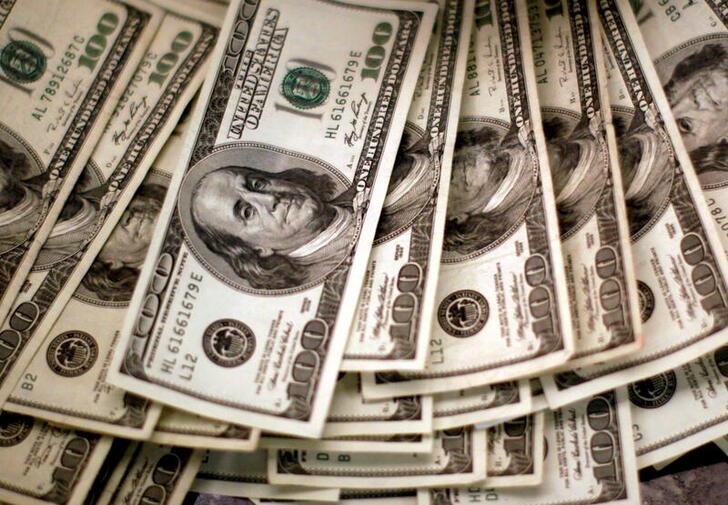By Gertrude Chavez-Dreyfuss
NEW YORK (Reuters) -The U.S. dollar rose to a nine-month high on Thursday, as worries about widespread coronavirus infections and Federal Reserve meeting minutes showing it was considering reducing pandemic-era stimulus this year hit global stocks and commodity-linked currencies.
The dollar index, which measures its performance against six currencies, hit 93.587, its highest since early November of last year. It was last up 0.3% at 93.359.
A decline in debt purchases by the Fed is widely considered positive for the dollar as it is expected to raise U.S. government bond yields, making it more attractive for investors to hold dollar-denominated assets.
The minutes of the Fed's July meeting showed officials largely expect to reduce their monthly bond buying later this year, but consensus on other key issues appeared elusive, including the timing of the start of the taper and whether inflation, joblessness or the coronavirus pandemic pose a bigger risk to economic recovery.
Vassili Serebriakov, FX strategist at UBS in New York, said market expectations ahead of the Fed minutes were probably for a taper later than 2021. "But I don't think the view that the Fed may taper by the end of the year should come as a surprise," Serebriakov added.
The Fed minutes, along with sustained worries about the spread of COVID-19, pushed Wall Street stock indexes lower. European markets were down as well on Thursday, while safe-haven U.S. Treasuries gained, with benchmark 10-year yields 3 basis points lower at 1.241%.
The dollar hardly reacted to weekly unemployment data showing that the number of people on state jobless rolls dropped in early August to levels last seen in mid-March 2020.
Serebriakov believes the dollar's rally was more about negative risk sentiment related to among others, the Delta coronavirus variant and the slowdown in China.
The euro fell as low as $1.1665 against the dollar for the first time since early November, and was last down 0.3% at $1.1676. Sterling fell 1% to $1.3642.
With pandemic fears in focus and oil prices falling, commodity-exposed currencies fell sharply on Thursday.
The Norwegian crown extended its fall against the euro even as the country's central bank kept interest rates on hold and reiterated plans to hike them in September.
Norway's currency fell to its lowest since July against both the dollar as well as the euro, and were last down 1.6% at 9.0365 crowns and 1.3% at 10.553, respectively.
The Australian and New Zealand dollars slid to their lowest levels since November 2020. The Aussie dollar last traded down 1.2% at US$0.7149, while the New Zealand unit dropped 0.8% to US$0.6827.
The Kiwi dollar extended its losses, when New Zealand entered a new lockdown, delaying its central bank from becoming the first in the G10 from raising rates during the pandemic.
========================================================
Currency bid prices at 2:59 PM (1859 GMT)
Description RIC Last U.S. Close Pct Change YTD Pct High Bid Low Bid
Previous Change
Session
Dollar index 93.5560 93.2240 +0.37% 3.973% +93.5870 +93.2140
Euro/Dollar $1.1675 $1.1709 -0.29% -4.44% +$1.1716 +$1.1666
Dollar/Yen 109.8000 109.7600 +0.04% +6.27% +110.2200 +109.4900
Euro/Yen 128.18 128.51 -0.26% +0.99% +128.7000 +127.9400
Dollar/Swiss 0.9185 0.9172 +0.17% +3.84% +0.9207 +0.9146
Sterling/Dollar $1.3639 $1.3752 -0.81% -0.16% +$1.3757 +$1.3638
Dollar/Canadian 1.2819 1.2664 +1.23% +0.68% +1.2830 +1.2649
Aussie/Dollar $0.7149 $0.7234 -1.17% -7.06% +$0.7243 +$0.7143
Euro/Swiss 1.0722 1.0734 -0.11% -0.79% +1.0746 +1.0697
Euro/Sterling 0.8558 0.8511 +0.55% -4.24% +0.8561 +0.8506
NZ $0.6829 $0.6885 -0.81% -4.89% +$0.6888 +$0.6810
Dollar/Dollar
Dollar/Norway 9.0375 8.8965 +1.64% +5.30% +9.0450 +8.9250
Euro/Norway 10.5528 10.4231 +1.24% +0.82% +10.5627 +10.4150

Dollar/Sweden 8.8063 8.7281 +0.62% +7.44% +8.8098 +8.7236
Euro/Sweden 10.2821 10.2183 +0.62% +2.04% +10.2901 +10.2153